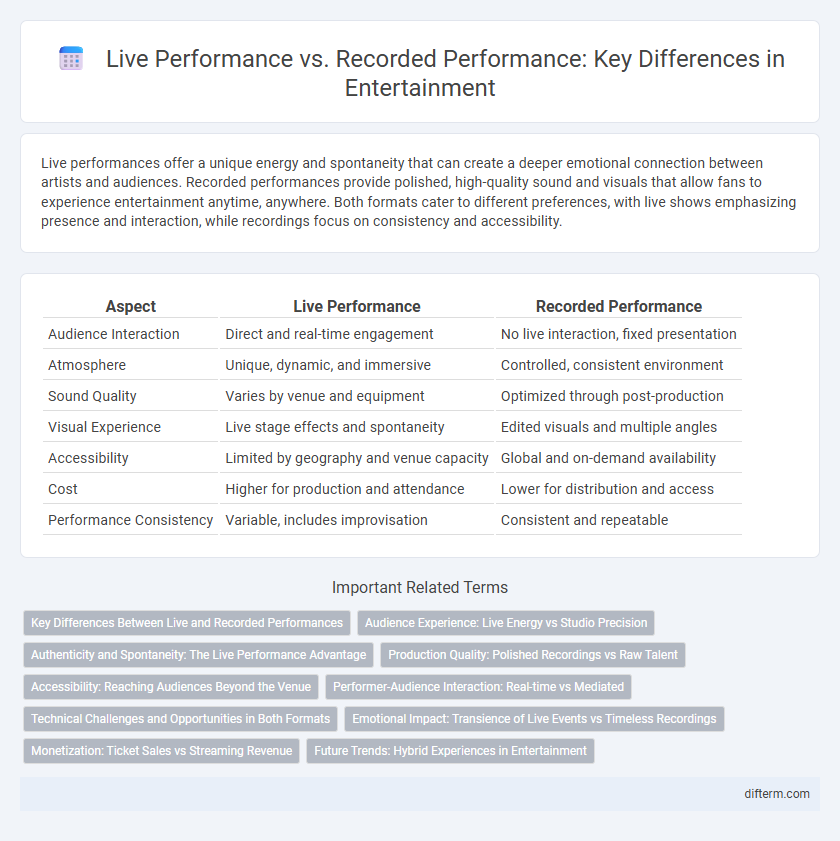Live performances offer a unique energy and spontaneity that can create a deeper emotional connection between artists and audiences. Recorded performances provide polished, high-quality sound and visuals that allow fans to experience entertainment anytime, anywhere. Both formats cater to different preferences, with live shows emphasizing presence and interaction, while recordings focus on consistency and accessibility.
Table of Comparison
| Aspect | Live Performance | Recorded Performance |
|---|---|---|
| Audience Interaction | Direct and real-time engagement | No live interaction, fixed presentation |
| Atmosphere | Unique, dynamic, and immersive | Controlled, consistent environment |
| Sound Quality | Varies by venue and equipment | Optimized through post-production |
| Visual Experience | Live stage effects and spontaneity | Edited visuals and multiple angles |
| Accessibility | Limited by geography and venue capacity | Global and on-demand availability |
| Cost | Higher for production and attendance | Lower for distribution and access |
| Performance Consistency | Variable, includes improvisation | Consistent and repeatable |
Key Differences Between Live and Recorded Performances
Live performances offer real-time interaction, spontaneous energy, and unique audience engagement that create an immersive experience. Recorded performances provide precise sound quality, multiple takes for perfection, and the ability to reach a global audience without time constraints. The immediacy and unpredictability of live shows contrast with the controlled, repeatable nature of studio recordings.
Audience Experience: Live Energy vs Studio Precision
Live performances generate a dynamic energy that fosters real-time interaction and emotional connection between artists and audiences, creating an immersive atmosphere that studio recordings cannot replicate. Recorded performances prioritize precision and technical excellence, allowing for meticulous sound engineering and multiple takes to achieve flawless delivery. The audience experience differs fundamentally, with live shows offering spontaneity and communal excitement, while studio recordings provide polished clarity and controlled sound quality.
Authenticity and Spontaneity: The Live Performance Advantage
Live performances capture authentic emotions and spontaneous moments that recorded performances often lack, creating a unique and immersive experience for the audience. The unpredictability of live shows allows artists to connect deeply with fans, showcasing raw talent and genuine reactions in real-time. This immediacy enhances the emotional impact, making each performance one-of-a-kind and irreplaceable.
Production Quality: Polished Recordings vs Raw Talent
Live performances showcase raw talent and authentic energy, capturing spontaneous moments that resonate with audiences in real time. Recorded performances benefit from advanced production techniques, delivering polished sound quality, precise editing, and visual enhancements that refine the overall experience. The contrast between the two lies in the unfiltered emotional connection of live shows versus the meticulously crafted perfection of studio recordings.
Accessibility: Reaching Audiences Beyond the Venue
Live performances offer unique, immersive experiences limited by geographic location and venue capacity, restricting accessibility for global audiences. Recorded performances break these barriers by enabling on-demand access through digital platforms, reaching millions worldwide regardless of time or place. Leveraging streaming services and social media amplifies audience engagement and inclusivity, transforming entertainment accessibility beyond physical venues.
Performer-Audience Interaction: Real-time vs Mediated
Live performances create dynamic, real-time interactions between performers and audiences, fostering immediate emotional exchanges and spontaneous energy shifts. Recorded performances offer mediated experiences where interactions are one-way, limiting audience influence but allowing repeated, convenient access to artistic content. The immediacy of live shows enhances engagement, while recordings prioritize consistency and broader reach.
Technical Challenges and Opportunities in Both Formats
Live performances demand real-time audio mixing and adaptive lighting systems to manage unpredictable factors such as audience interaction and technical malfunctions, requiring skilled technicians and resilient equipment. Recorded performances provide the opportunity for meticulous editing, sound engineering, and visual effects integration, enhancing overall production quality but relying heavily on post-production software and hardware capabilities. Both formats face challenges in maintaining audio fidelity and visual consistency while leveraging emerging technologies like spatial audio and high-definition video to elevate audience experience.
Emotional Impact: Transience of Live Events vs Timeless Recordings
Live performances deliver a unique emotional intensity driven by their transience, creating an irreplaceable connection between artists and audiences that cannot be replicated. The fleeting nature of these events heightens anticipation and presence, fostering a shared, communal experience charged with spontaneous energy. Recorded performances, by contrast, offer timeless access to artistry, allowing repeated enjoyment and in-depth analysis, but often lack the raw emotional immediacy intrinsic to live shows.
Monetization: Ticket Sales vs Streaming Revenue
Live performances generate significant revenue through ticket sales, merchandise, and exclusive on-site experiences, capitalizing on the immediacy and unique atmosphere of in-person events. Recorded performances, distributed via streaming platforms, offer continuous income through subscription fees and ad revenue while reaching a global audience without geographical restrictions. Artists commonly balance these monetization methods, leveraging live shows for high-ticket earnings and streaming for scalable, long-term revenue streams.
Future Trends: Hybrid Experiences in Entertainment
Hybrid experiences in entertainment are transforming live and recorded performances by integrating real-time audience interaction with high-quality recorded content, enhancing engagement through augmented reality and virtual reality technologies. Emerging trends include immersive streaming platforms that allow viewers to influence live shows and exclusive behind-the-scenes access, merging physical and digital realms seamlessly. This convergence is driving the future of entertainment, creating dynamic, multi-sensory experiences that cater to diverse audience preferences worldwide.
live performance vs recorded performance Infographic

 difterm.com
difterm.com